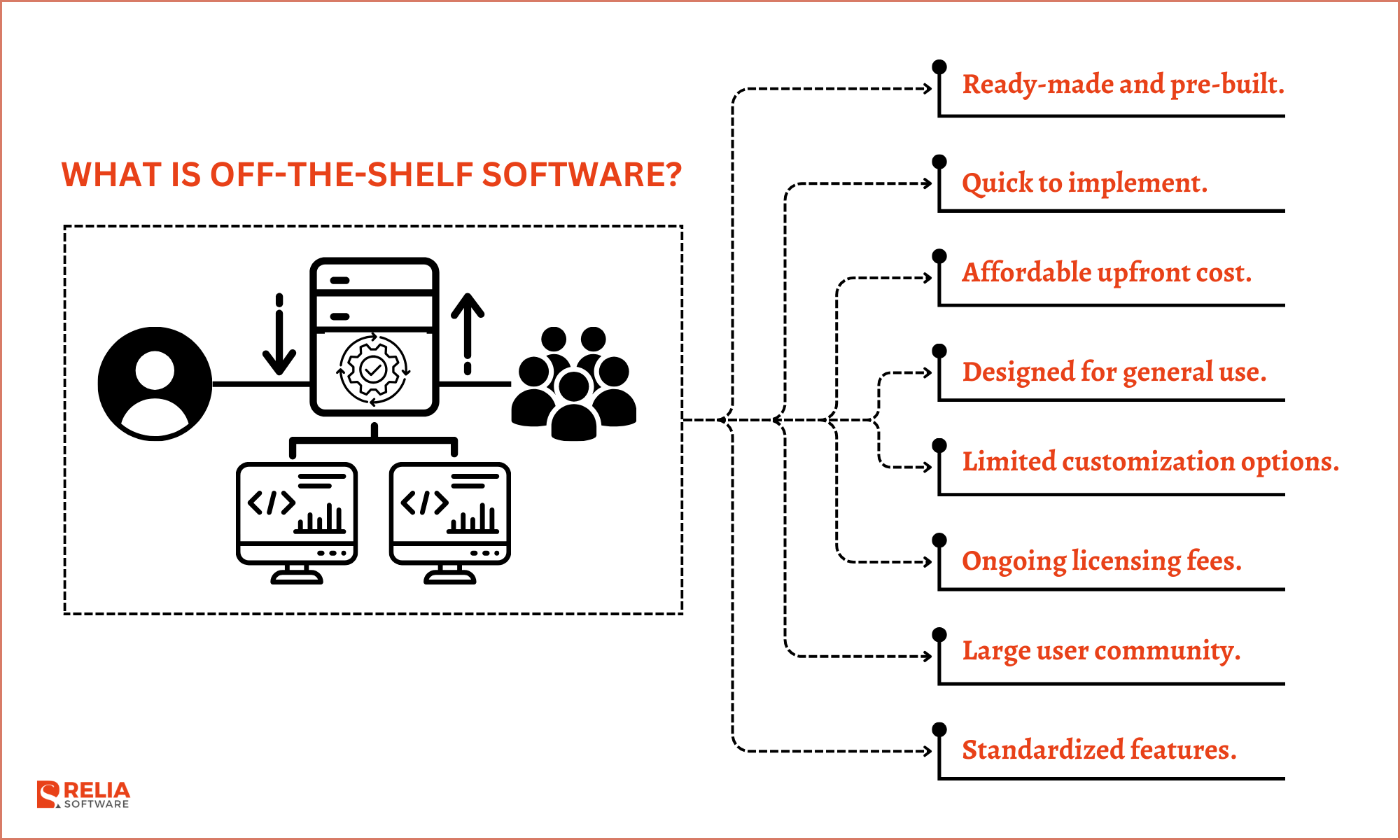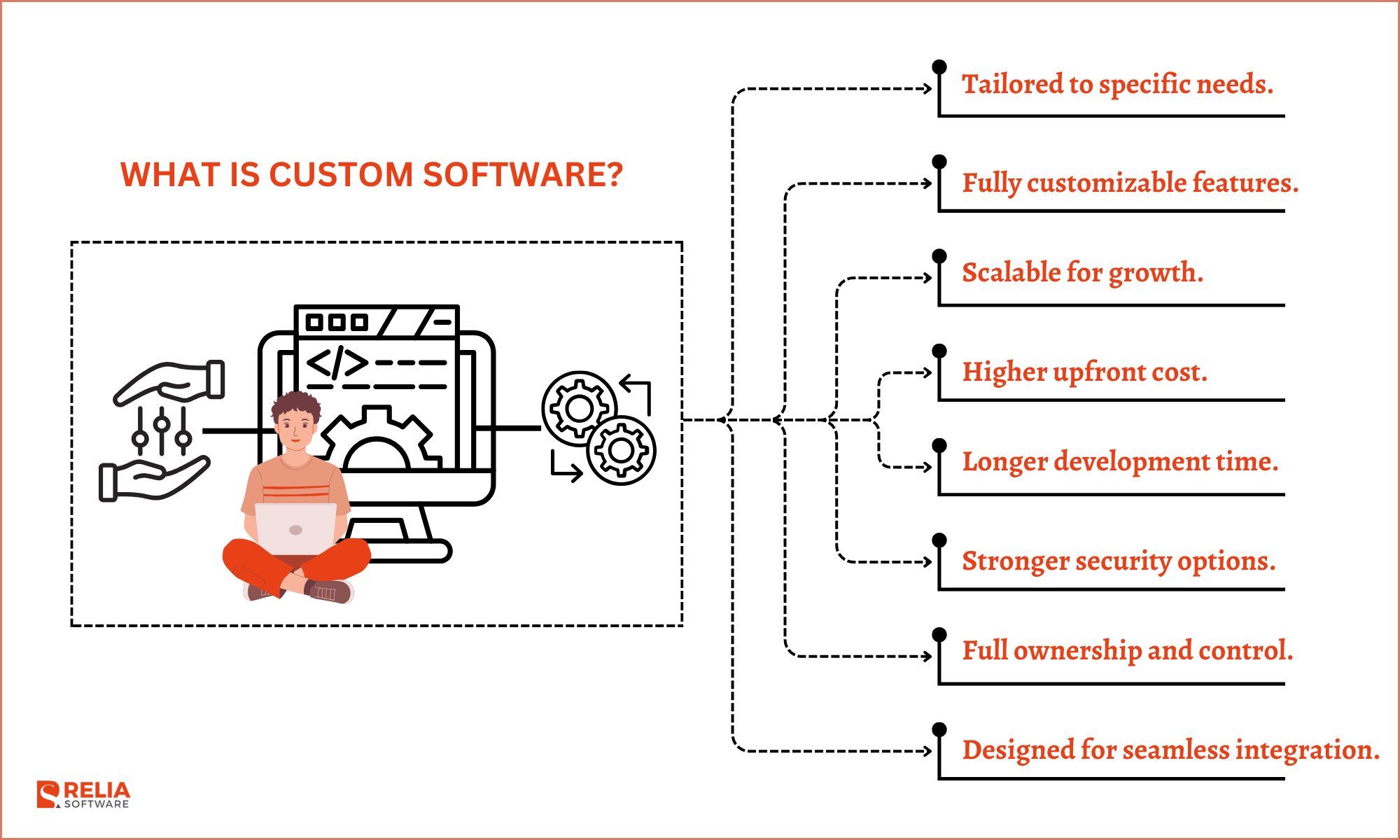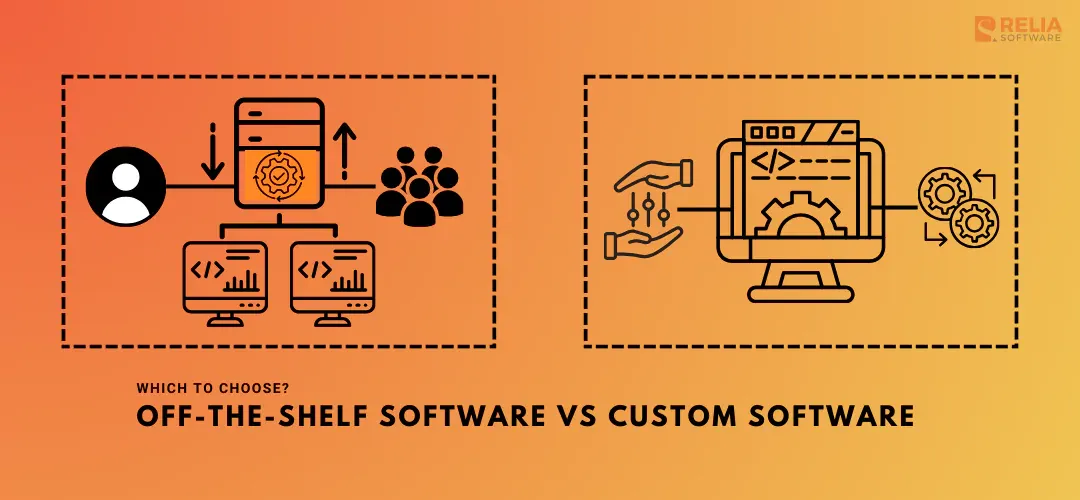When choosing software for your business, you may face a big question: should you buy off-the-shelf software or invest in a custom solution? Both options have their strengths and weaknesses, and the right choice depends on your business needs, goals, and budget. In this blog, I'll break down what makes these two options different, weigh their pros and cons, and help you choose the best fit for your business.
>> Read more: Unlock the Difference between Open-Source and Proprietary Software
What is Off-the-Shelf Software?
Off-the-shelf software is pre-built software that is ready to use as soon as you buy it. It’s designed to meet common needs of a wide range of users and businesses. It’s usually much cheaper and easy to set up, but it might not always fit your business perfectly since it’s not made specifically for you.

Advantages of Off-the-Shelf Software
-
Affordable: Off-the-shelf software is usually cheaper because the cost is spread across many users.
-
Ready to Use: You can start using it right away after purchasing since it’s already built and tested.
-
Reliable: It’s been used by many people overtime, so most bugs or issues are already fixed.
-
Regular Updates: Vendors often provide regular updates, patches, and technical support to keep the software running smoothly.
-
Large User Community: Many off-the-shelf tools have a wide user base, so you can find many resources, forums, and third-party guides for help and tips.
Disadvantages of Off-the-Shelf Software
Here are some aspects to consider when purchasing off-the-shelf software:
-
Limited Customization: Off-the-shelf software is built for general use, so it might not fit your specific business needs perfectly.
-
Unnecessary Features: It often has many features you don’t need, so you can sometimes feel it is hard to use.
-
Integration Issues: Although most off-the-shelf software works well with popular platforms, it might not connect easily with older or specialized systems your business uses. You might need extra tools or work to get everything running smoothly.
-
Ongoing Costs: You might have to pay for subscriptions, licenses, or upgrades over time, which can add costs overtime.
-
Vendor-Dependent: You rely on the vendor for updates and support, which could be a problem if they stop maintaining the software.
-
Hard to Scale: As your business grows, the software might not be able to scale or handle your changing needs.
5 Examples of Off-the-Shelf Software
-
Salesforce: Salesforce helps businesses manage customer relationships, track leads, and boost sales. It’s widely used because it’s customizable for different industries.
-
Slack: Slack is a messaging tool for teams to communicate and collaborate. It started as an internal tool but is now used by businesses of all sizes.
-
SAP: SAP is a system that helps businesses manage things like accounting, HR, and supply chains all in one place.
-
QuickBooks: QuickBooks makes it easy for small and medium businesses to handle accounting tasks like tracking expenses, invoicing, and payroll.
-
HubSpot: HubSpot is an all-in-one platform for managing marketing, sales, and customer service. It’s user-friendly and great for businesses to grow.
What is Custom Software?
Custom software is a tailor-made solution created specifically for a business to meet its unique needs. Unlike off-the-shelf software, it’s built from the ground up to match specific goals, workflows, and challenges. It offers full flexibility and scalability, making it a perfect fit for how a business operates. However, developing custom software takes more time and resources than ready-made options.

Advantages of Custom Software
-
Built for Your Needs: Custom software is made specifically for your business, ensuring it works exactly the way you need it to.
-
Easy to Scale: It’s designed to scale, so as your business grows or changes, the software can evolve to meet new demands.
-
Competitive Advantage: A custom solution can help your business stand out by offering unique features that your competitors don’t have.
-
Integration with Existing Systems: Custom software can be built to seamlessly work with your current tools and systems, making operations smoother.
-
Stronger Security: Custom software can include advanced security features tailored to your business, reducing risks compared to generic software.
-
No Unnecessary Features: You’ll only get the features you need, without extra functions that clutter or complicate the software.
-
Long-Term Cost Effectiveness: While it costs more upfront, custom software avoids ongoing licensing fees, saving money in the long run.
Disadvantages of Custom Software
-
High Upfront Cost: Custom software can be expensive to build initially, which might not be ideal for small businesses.
-
Longer Development Time: Since it’s made from scratch, it can take months—or longer—before the software is ready to use.
-
Takes Time to Plan: You’ll need to spend a lot of time planning and defining your requirements before development even starts.
-
Risk of Too Many Features: Adding too many custom features can make the software complicated and expensive without adding much value.
-
Requires a Dedicated Development Team: You need to hire a talented development team that can adapt to your project. Or, you need a reliable outsourcing partner to support the project from start to end.
>> You can consider: Detailed Breakdown For App Development Cost
5 Examples of Custom-Written Software
-
Nike: Nike created its own custom e-commerce platform for its website and mobile app. It includes personalized product recommendations, exclusive features for members, and the Nike By You customization service.
-
Uber: Uber built its own platform to connect riders with drivers. It includes custom apps for both, along with systems for matching rides, calculating prices, and tracking locations in real time.
-
Spotify: Spotify developed its own music streaming platform with custom technology for smooth playback and personalized playlists, helping users discover music they’ll love.
-
Airbnb: :Airbnb created its own software to handle property listings, bookings, payments, and user reviews. It’s also built to give personalized suggestions to travelers.
-
Starbucks: Starbucks made its own app that lets customers order ahead, track rewards, and get personalized offers, making their experience quicker and more convenient.
Comparison of Off-the-Shelf Software vs Custom Software
|
Criteria |
Off-the-Shelf Software |
Custom Software |
|
Upfront Cost |
Lower |
Higher |
|
Development Time |
Ready to use immediately. |
Longer to build. |
|
Customization |
Limited |
Fully customizable |
|
Scalability |
Difficult |
Easy |
|
Integration |
Limited |
Built to integrate easily |
|
Features |
Standard features, some irrelevant. |
Only features you need. |
|
Time to Market |
Quick |
Longer |
|
Security |
General |
Stronger |
|
Ownership |
Licensed, not fully owned. |
Fully owned by your business. |
|
Support |
Vendor-provided, often generic. |
Dedicated and personalized. |
|
Long-Term Costs |
Fees for licenses and upgrades. |
No licenses; mainly maintenance costs. |
|
Reliability |
Well-tested, stable. |
Depends on development quality. |
|
User Community |
Large user base for external help. |
No community, but custom documentation provided. |
|
Flexibility |
Limited |
Highly flexible |
|
Best for |
General needs, tight budgets, small businesses. |
Unique workflows, scalability, long-term growth. |
When to Use Off-the-Shelf Software?
-
Budget Constraints: If you have a limited budget and need an affordable solution.
-
Quick Implementation: When you need software that’s ready to use right away without a long development process.
-
Standard Needs: If your requirements are common and don’t need customization (e.g., accounting, email marketing).
-
Short-Term Use: For projects or tasks that don’t require long-term investment in a software solution.
-
Established User Base: When you prefer well-tested, reliable software with community support and frequent updates.
When to Use Custom Software
-
Unique Business Processes: If your business has specific workflows or needs that generic software can’t address.
-
Scalability: When you expect your business to grow and need software that can adapt and scale with you.
-
Competitive Advantage: If you want a solution that is different from your competitors with unique features or capabilities.
-
Integration Requirements: When you need software that works seamlessly with your existing systems and tools.
-
Data Security: If your business handles sensitive data and requires strong security measures.
-
Long-Term Investment: When you’re willing to invest more upfront for a solution that saves money over time with no licensing fees.
Conclusion
Deciding between off-the-shelf software and custom software comes down to what your business needs, your budget, and your goals. Off-the-shelf software works well if you need something quick, affordable, and ready to handle common tasks. Custom software is the better choice if you have unique processes or need a solution that can grow with your business. Take the time to think about your challenges and long-term plans to choose the option that best supports your business.
>>> Follow and Contact Relia Software for more information!
- development

